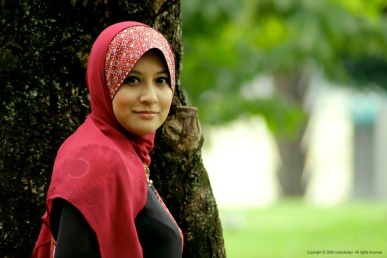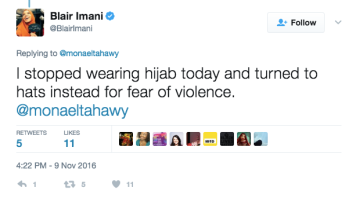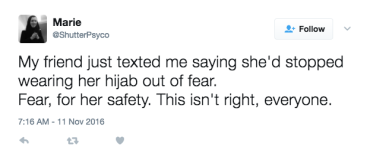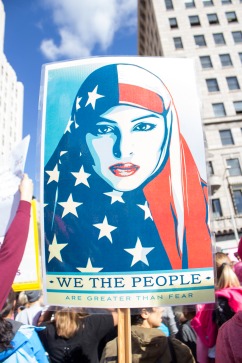“This is the time when the patience of Muslims is being tested. We’re not supposed to react how we want to. I got stared down by a cop, I’ve never been stared down… I was very scared, embarrassed, ashamed” (Sara, college student, from Peek 2010: 309).*
Today’s American Muslim community shares Sara’s feelings of fear and confusion. Although Sara gave this account following the events of 9/11, frighteningly, these stories could be easily misinterpreted as reactions to America’s current political climate. After a xenophobic and misogynistic presidential campaign fueled by public opposition towards Islam, Donald Trump’s election in November 2016 sparked uncertainty and fear amongst the Muslim community in the United States (Trump 2015).

Woman in a red hijab, photo courtesy Riza/Flickr
Many Muslim women in particular fear for their safety (Sakuma 2016). The hijab, a simple scarf wrapped around a woman’s head and neck, which is one of the most visual symbols of the Islamic faith, has made Muslim women a target for xenophobic attacks (Sakuma 2016; Shelbayah 2016). Immediately after Donald Trump’s election, Muslim women, including Blair Imani and Marie (@shutterpsyco), took to social media to publicly express their fear in wearing hijab.

Image via Twitter

Image via Twitter
These women decided that wearing the hijab made them too vulnerable to an attack; they stopped wearing their scarves. No one should have to remove a physical representation of their faith in order to comply with others’ opinions.
Remarkably, despite immense societal pressure for women to remove their headscarves, the hijab has become a powerful representation of inclusion, piety, and resistance against Islamophobia (Shelbayah 2016; Abassi 2017). Fara Arefi knows first-hand how a headscarf can put a target on your back. A few years ago Fara, who started wearing a hijab at 17 years old, got in a bad car accident because her car tires had been slashed. She admits that “it was the scariest moment of my life.” Afterwards, she felt an even stronger desire to wear the hijab (Náñez 2017). Today, her hijab is a symbol of defiance against hatred. She refuses to give into societal pressures to sacrifice her commitment to her religion. Fara’s motivations are not unique to her situation. Sociologist Lori Peek found many Muslim youth gained a strengthened religious identity post-9/11 in the face of increased discrimination (2010). The pattern still exists among many Muslims today in Trump’s America (Náñez 2017).

Photo courtesy of Puro/Flickr
Professor at the College of Business and Mass Communication at Brenau University, CNN producer, and self-identified Muslim Slma Shelhayah admits that following Donald Trump’s election she wondered if it was safer to take off her hijab in order to look less Muslim (Shelbayah 2016). Non-Muslims in American society often forget that hijab is a personal choice among Muslim women in the United States, and there are various reasons why women choose to wear it (Read 2000). Whether women wear it for social reasons or to showcase their commitment to Islam, the hijab represents a woman’s self-identity as a Muslim and fights societal uniformity in America (Read 2000). Islam helped Slma realize her hijab was a powerful tool: “My faith whispers to keep it on in defiance of fear — and in my conviction that diversity is a right and a strength in this country” (Shelbayah 2016). While the hijab symbolizes diversity, it is also a reminder that religious beliefs and what one chooses to wear should not divide people.
Contemporary America is beginning to realize that discrimination against Muslim women occurs regularly. Realizing the inclusive symbolism of the hijab and its messages of unity and respect, numerous non-Muslim women have begun to wear the hijab in solidarity with other Muslim woman (Abassi 2016). The hijab, and the women who wear it, are challenging Americans to accept cultural differences and find the similarities amongst our diverse population.
I really enjoyed this post on the Hijab after the election of President Trump. I never realized the importance and dispute surrounding the Hijab. As a result of the election and growing Islamophobia, the Hijab simultaneously draws attention to a minority identity and reflects the unity and strength of a targeted community. It would be interesting to do more interviews interview and look at more data to see how the election has changed the perception of the Hijab.
LikeLike
This post connects really well to widely public disputes in France over overt religious wear in public spaces and brings to light a key issue in expressing religious identity: when it is public and when it is private. It is frightening that people would act violently against a personal display of religion and this is especially dangerous because violent acts are racially and religiously charged. I too would like another study following Peek to compare reactions to public displays of Islam after this election with the Islam after 9/11 as Peek studied.
LikeLike
I thoroughly enjoyed reading this blog. It eloquently highlights the devastating decisions some individuals have had to make since the election. It provides an understanding of the symbolism of the Hijab and highlights how the use may begin to take a new form. I’d be curious to see if the Hijab evolves to be a symbol of resistance against the Islamophobia in our country. Moreover, I hope that the world as a whole begins to respect the usage of the Hijab.
LikeLike